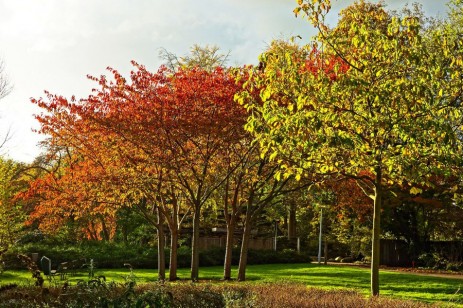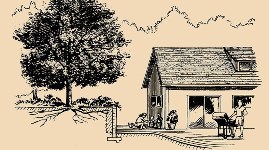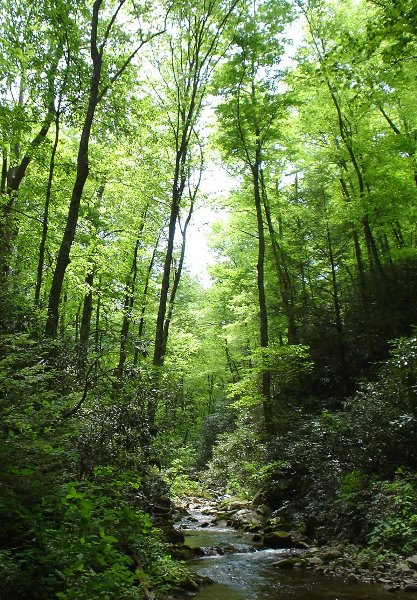 The following web resources provide comprehensive information to assist local jurisdictions with initiating and completing successful urban tree canopy plans, including scientific information to make the case for urban tree canopy protection, approaches for completing tree inventories, promoting tree planting, and ensuring successful long-term urban forestry practices.
The following web resources provide comprehensive information to assist local jurisdictions with initiating and completing successful urban tree canopy plans, including scientific information to make the case for urban tree canopy protection, approaches for completing tree inventories, promoting tree planting, and ensuring successful long-term urban forestry practices.
Urban & Community Forestry: A Practical Guide to Sustainability -
(Arbor Day Foundation)
Downloadable in English or Spanish, this illustrated publication focuses on the policies, coalition building, and community support necessary for sustainable local forestry. A sampling of the chapter titles hints at this purpose: Collaboration--The Key to Sustainability; A Common Cause--Creating Attainable Goals; Know Your Audiences and Their Needs; Multi-Cultural Communities--Addressing the Needs of All; Collaborating with Volunteers, Schools and Utilities; Building Stakeholder Capacity; Securing Financial Support; and Policies and Programs Essential for Sustainability.
Vibrant Cities Laboratory (Urban Forestry Toolkit: The U.S. Forest Service
Step-by-Step Guide to Implementing Urban Forestry in Your Community)
 The vast Vibrant Cities urban forestry website offers this useful guide. It contains information on street tree inventories, prioritizing tree plantings, building a stakeholder coalition, making the case for action, planning for best practices in urban forestry, promoting better forestry on private land, funding, and promoting trees in all policies.
The vast Vibrant Cities urban forestry website offers this useful guide. It contains information on street tree inventories, prioritizing tree plantings, building a stakeholder coalition, making the case for action, planning for best practices in urban forestry, promoting better forestry on private land, funding, and promoting trees in all policies.
Riparian Forest Buffers (University of Maryland Extension)
Riparian forest buffers grow along the borders of waterways and provide a host of environmental benefits. This website provides a menu of related topics including: an overview on riparian forest buffers and their functions and values; establishment, recommended species, and incentive programs; and a video focusing on the link between land and water.
Urban and Community Forestry (Maryland DNR)
 Maryland DNR is responsible for the management and protection of the state's urban forestry resources. Within DNR’s Forest Service, direct oversight of these resources is provided by the Urban and Community Forestry Program (U&CF). The website provides links to Maryland’s tree-protecting laws—Forest Conservation Act,
Maryland Reforestation Law,
Maryland Tree Expert Law, and Roadside Tree Law—recognition programs such as Tree City USA, volunteer opportunities such as TreeMendous Maryland, and published reviews on the effectiveness of the Forest Conservation Act.
Maryland DNR is responsible for the management and protection of the state's urban forestry resources. Within DNR’s Forest Service, direct oversight of these resources is provided by the Urban and Community Forestry Program (U&CF). The website provides links to Maryland’s tree-protecting laws—Forest Conservation Act,
Maryland Reforestation Law,
Maryland Tree Expert Law, and Roadside Tree Law—recognition programs such as Tree City USA, volunteer opportunities such as TreeMendous Maryland, and published reviews on the effectiveness of the Forest Conservation Act.
Chesapeake Tree Canopy Network
A colllaboration of the Chesapeake Bay Program, Alliance for the Chesapeake Bay, and the U.S. Forest Service, this site connects users with “resources, stories, and best practices to understand your canopy, expand your canopy, and maintain your canopy.” It contains a wealth of links to tree canopy initiatives, including an interactive map to find tree canopy assessments, goals, and urban forestry contacts in dozens of jurisdictions in Maryland and elsewhere in the Chesapeake watershed.
Green Cities: Good Health (U.S. Forest Service, University of Washington: College of the Environment)
This web site provides the scientific evidence that supports efforts to better plan, implement, and manage nature in cities. Research findings are sorted and summarized across benefits themes that include healing, safety, and community building.
Open Green Cities: Good Health webpage
ANSI A300 Standards
ANSI A300 standards are the generally accepted voluntary industry consensus standards for tree care practices. The standards apply to professionals who provide for or supervise the management of trees, shrubs, and other woody landscape plants. Intended users include businesses, government agencies, property owners, property managers, and utilities. The standards do not apply to agriculture, horticultural production, or silviculture, except where explicitly noted otherwise. Part 1 (pruning), Part 2 (soil management), Part 5 (management of trees and shrubs during site planning, site development and construction), Part 8 (root management) and Part 10 (integrated pest management) are of particular relevance.
Open ANSI A300 Standards
Financing Urban Tree Canopy Programs: Guidebook for Local Governments in the Chesapeake Bay Watershed
This well-illustrated publication from March 2019 was prepared by the Environmental Finance Center at the University of Maryland and the Alliance for the Chesapeake Bay. First, the report describes the benefits of urban forests, the progress of urban tree canopy (UTC) efforts in the Chesapeake Bay watershed, and the state policies and programs that affect UTC funding. Next, the report provides guidance on how to build support for tree canopy funding and to stretch those dollars as far as possible. Finally, the report provides a dozen case studies of successful UTC funding efforts in watershed communities. An appendix lists resources available to support UTC programs.
Financing Urban Tree Canopy Programs